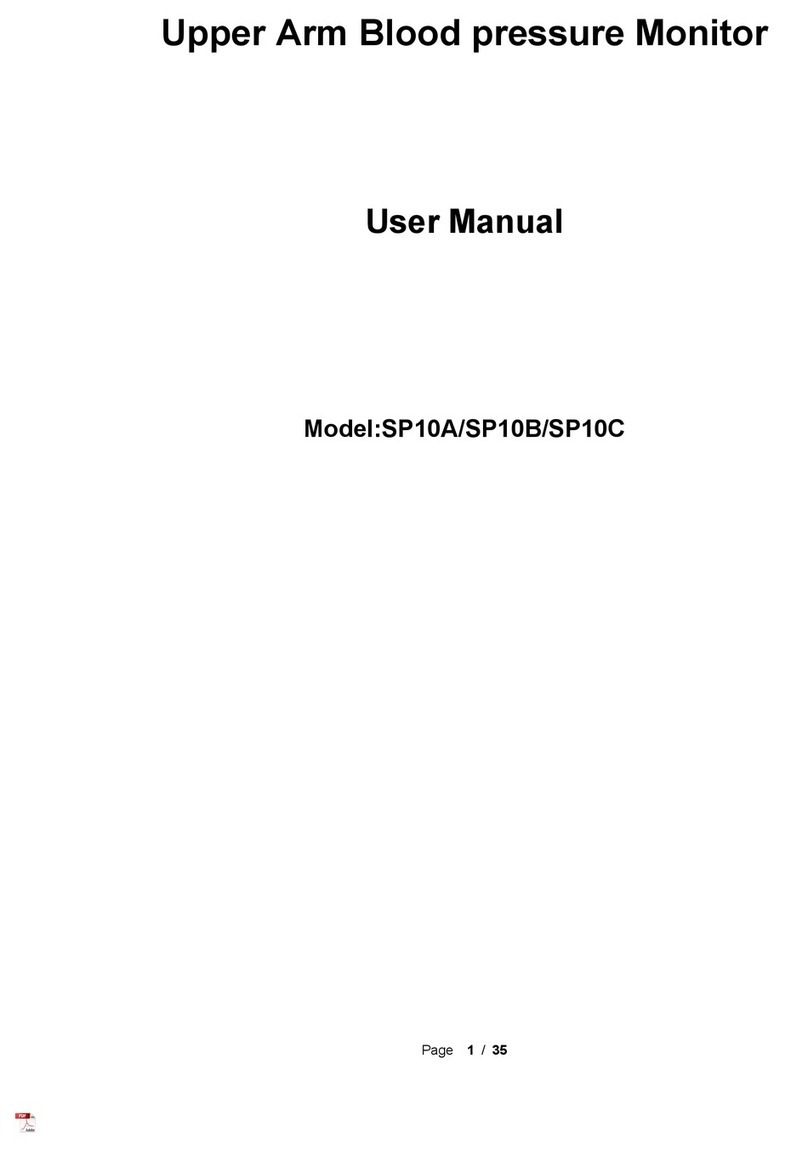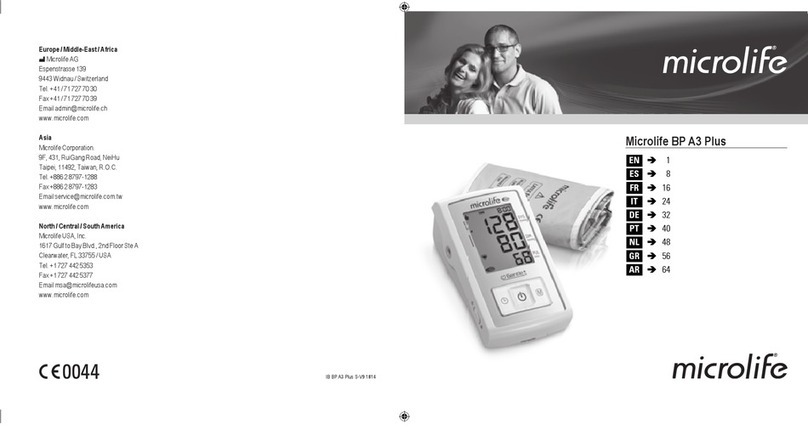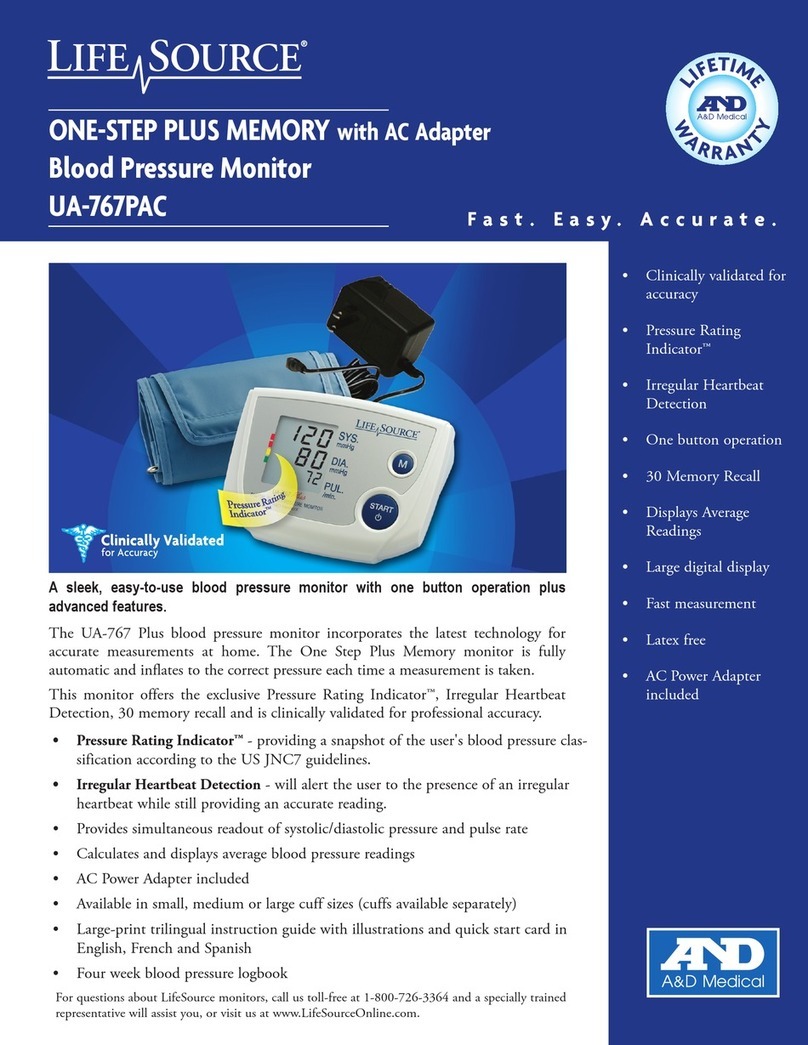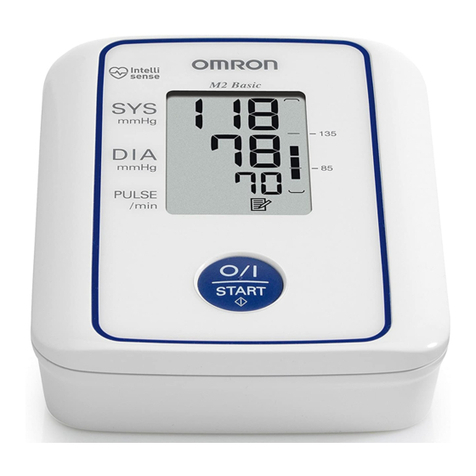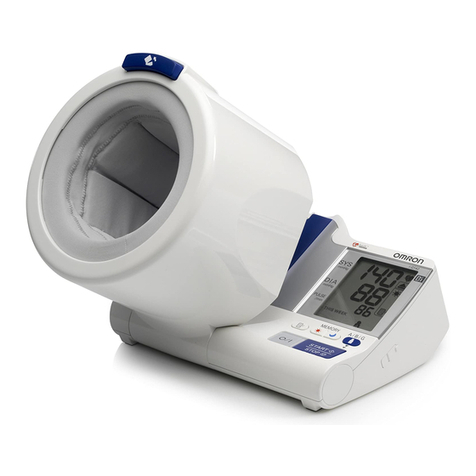Medxing ESM201 User manual

ESM201
User Manual
Please read the user manual carefully before using this device.
Digital Blood Pressure Monitor
(Upper Arm type)
* The picture is for reference only, the actual item is the standard.
Shenzhen Med-link Electronics Tech Co., Ltd
Shanghai International Holding Corp. GmbH (Europe)
Eiffestrasse 80, 20537 Hamburg, Germany
Tel: +49-40-2513175 Fax: +49-40-255726
REV
A.0
4th and 5th Floor, Building Two, Hualian Industrial
Zone, Xinshi Community, Dalang Street, Longhua
District, 518109 Shenzhen, CHINA
Website:www.medxing.com


1
1
1
2
3
3
4
4
5
5
5
5
6
7
7
7
8
8
9
9
9
9
10
10
11
11
16
16
16
17
Table of Contents
1. Important Safety Instructions
1.1 Warning
1.2 Precaution
2. Intended Use & Product Feature
3. Preparation before Use
3.1 Install or Replace Batteries
3.2 System Setting
3.3 User Choice
4. Take a Measurement
4.1 Important Notes
4.2 Applying the Cuff
4.3 Correct Body Posture during Measurement
4.4 Take a Measurement
4.5 Memory
4.5.1 Memory Recall
4.5.1 Clear Memory
5. Error Indication
6. Troubleshooting
7. Maintenace and Storage
7.1 Maintenace
7.2 Storage
7.3 Disposal
8. Warranty
9. Technical Specifications
10. Device Symbols
11. Electromagnetic Environment
12. About Blood Pressure
12.1 What is Blood Pressure
12.2 What is High Blood Pressure
12.3 What is Morning Hypertension
● Never diagnose or treat by yourself only based on the blood pressure measurement result
since self-diagnose or self-treat may make the illness get worse. Please follow the doctor’s
directions.
● For the patient with blood circulation disorder or blood disease, please use this device under
doctor’s instructions.
● It may be a risk when the cuff bladder is inflated for too long time.
● This device is not applicable for neonatal, infant and the people who can’t express his/her thought.
● This device is used to non-invasive measure human body’s blood pressure. Do not use it for
other purpose.
● Do not use this device close to strong electromagnetic fields such as mobile telephones or
radio installations.
● For the people has irregular heartbeat (such as APB, VPB or AF) the measurement results
may be inaccurate or the blood pressure can’t be measured successfully.
● Diabetes, hyperlipemia, hypertension etc. diseases will accelerate atherosclerosis and also
will cause peripheral blood circulation disorder.
● Please operate, transport and store this device in the environment noted in this manual.
Otherwise inaccurate measurement results will be obtained.
● Keep away from children because some parts are small enough to be swallowed.
● The operator shall not touch battery connectors and the patient simultaneously.
● Do not use rechargeable batteries.
● The user must check that the device functions safely and see that it is in proper working
condition before being used.
● Do not open, alter or repair this device by yourself.
● Do not pull the upper arm cuff with excessive force. Do not twist it.
● Only pump up the cuff once fitted.
● Do not impact, drop, trample and shake the device.
● Only use the cuff provided by Med-link to ensure the measurement accuracy.
1.Important Safety Instructions
1
Warning
Precaution

Health status
Diastolic value
Date
Time
Voice status
Unit:mmHg or Kpa
User choice
Measurement
times
Systolic value
Pulse icon
Low battery
indicator
⑦
⑤
⑥
④
①
③
②
Product function: Measure and display systolic and diastolic blood pressure and pulse rate. It
can store 2x90 sets memory (2 users, 90 sets memory for each user).
Intended use: It is intended to measure adult’s systolic and diastolic blood pressure and pulse
rate on upper arm.
Applicable upper arm circumference: 22cm~32cm.
2.Intended Use & Product Feature
Figure 1 Device configuration and LCD full display
Cuff connector
Cuff
Air hose
2
⑨
⑧
① ON/OFF button ② MEMORY button
③ SET button ④ USER button
⑤ DOWN button ⑥ UART port
⑦ LCD display ⑧ Cuff socket
⑨ Battery compartment cover
3.1 Install or Replace Batteries
Open battery compartment cover ⑨and insert batteries to ensure the polarity (<+>
and <->) of the batteries are correct and then close it. If the low battery icon
displayed please replace the batteries immediately. (See Figure 2)
● Use 4pcs AA alkaline battery.
● Do not mix different types of batteries, or an old battery with a new one.
● Remove the batteries if the device is not going to be used for long time.
● Reset the time and date after replacing the batteries.
Figure 2
4XAA alkaline battery
Battery compartment cover
3
3.Preparation before Use

3.2 System Setting
3.3 User Choice
1) Hold SET button ③for approx. 3 seconds when the device is switched off, the year
number flashes on the display.
2) You can set the year by pressing MEMORY button ②or DOWN button ⑤.
3) To confirm and the year by pressing the SET button ③.
4) Repeat step 1) to 3) to set the month, day, hour and minute.
5) After setting the minute is finished press SET button ③to confirm and then enter to
set the blood pressure unit.
6) Press MEMORY button ②or DOWN button ⑤to shift between mmHg and kPa
then confirm it by pressing SET button ③. After that you can enter to voice setting.
7) Press MEMORY button ②or DOWN button ⑤to shift between ON and OF (ON
means voice guided is switched on, OF means it is switched off) and confirm it by
pressing SE --T button ③. Then switch off the device.
8) Press SET button ③you can review the current date, time and user.
You can see the current user by pressing User button ④then shift the user by
pressing this button again. After that you can save this user as current user by
pressing ON/OFF button ①to switch off the device.
4
4.1 Important Notes
4.2 Applying the Cuff
4.3 Correct Body Posture during Measurement
To ensure the measurement accuracy please follows the below suggestions:
●
Do not eat, drink, smoke or exercise before measurement.
●
Take the measurement after urination and defecation.
●
Sit down for at least 10 minutes before measurement and relax.
●
Take the measurement in a quiet environment. Do not move or talk when take the
measurement.
●
Leave a small break of 2~3 minutes between two measurements.
●
Try to take your measurement at the same time in every day.
●
Support your arm in a relaxed position and ensure that the cuff is at the same
height as your heart (Figure 3).
●
Relax, do not move and do not tense your arm muscles. Breathe normally and do
not talk.
1) Connect the cuff to the device by inserting the cuff connector into the cuff socket ⑧.
2) Remove the close-fitting garments from the upper arm. The shirt sleeves should not
be rolled up if they are laid flat.
3) Place the cuff over your left upper arm with your left palm facing upward and leaving a
clearance of approximately 2~3cm between the cuff and the elbow. The air hose outlet
must lie over the artery which runs down the inner side of the arm (Figure 3).
4) Fit the cuff closely, but not too tight.
5) If you can not apply the cuff on the left upper arm, you also can take a measurement
using the right upper arm position.
Figure 3
5
4. Take a Blood Pressure Measurement

4.5 Memory
4.5.1 Memory Recall
4.5.2 Clear Memory
When the device is power off or stand-by press MEMORY button ②it will display the
average value of the last three measurement results. You can recall the measurement
by pressing MEMORY button ②or
DOWN button ⑤. If the measurement result is displayed together with flashed pulse
icon it means irregular heartbeat is detected during that measurement.
If the voice guided function is ON the device will read the measurement result via voice.
You can exit from memory recall by pressing ON/OFF button ①at any time.
Before clear the memory please confirm that the stored measurement results are
useless to you. We suggest you writing down your measurement results as blood
pressure diary to provide necessary information for your doctor.
If you decide to clear all stored memory you can press the MEMORY button ②to enter
to memory status when the device is power off or stand-by. Then hold the MEMORY
button ②for 3 seconds till “00” displayed.
Please note: you can’t delete individual stored measurement result.
7
4.4 Take a Measurement
Please follow the below steps to take a blood pressure measurement after preparation is
finished. (List blood pressure is mmHg for example)
1) Press ON/OFF button ①the device will turn on and LCD display will show all
segments for 1 second. Then “0” will flash and the cuff will start to inflate
automatically. If the voice guided function is ON the device will provide voice instructions.
2) When the correct pressure is reached, the pumping stops and the pressure falls
gradually. The pulse Icon will flash when the pulse signal is detected.
3) After measurement is finished the cuff will deflation automatically then the
systolic/diastolic blood pressure, pulse rate and blood pressure unit will be displayed and
stored. If the voice guided function is ON the device will read the measurement result via
voice. If irregular heartbeat is detected the pulse icon will flash.
● When the systolic pressure ≥140 mmHg (18.7 kPa) and/or diastolic
pressure ≥90 mmHg (12 kPa) the data displayed on LCD will flash that
reminding your blood pressure is abnormal. If the voice guided function is
ON the device will remind you via voice.
● If you feel any uncomfortable such as the cuff is inflated for a long time it may be a risk.
You must stop the measurement by pressing ON/OFF button ①.
● If the cuff pressure is over 300 mmHg (40 kPa) without deflation automatically please
remove the upper arm cuff.
● Repeat measurements will cause the upper congestion and then affect the measurement
result. Improvement method: remove the cuff and relax for 2~3 minutes then take a
measurement again.
The values measured by yourself in home may be lower than those measured in hospital
because you feel more relax and comfortable in home. The daily blood pressure
measurement is very important to manage your blood pressure. But even you take blood
pressure measurements in home the following situations may cause the blood pressure
values changing:
- In a hour after dining;
- After drinking wine, coffee or tea;
- After smoking, exercise or bathing;
- Nervous or emotional instability;
- Talking or movement during measurements;
- The ambient temperature is changed rapidly;
- Continuous measurement for long time
Please follow the doctor’s directions instead of diagnose by yourself based
on the measurement result.
● Always measure on the same position.
● The blood pressure is affected by many factors.
6
Warning
Warning

7.1 Maintenance
7.2 Storage
7.3 Disposal
●
Please often clean the device
●
Use a soft, dry cloth to clean the surface of this device when it is dirty.
●
Use an alcohol swab or cotton tissue moistened with alcohol (70% Isopropyl) to
clean the housing when it is very dirty and then use a dry cloth.
●
Never use abrasive cleaning agents, thinners or benzene or other cleaning liquids.
●
Take care not to scratch the surface of the sensor lens and LCD display.
●
Clean the upper arm cuff with a damp cloth and mild detergent.
Do not wash the upper arm cuff using washer or dish-washing machine.
●
The device requires no calibration.
●
The device is not repairable and contains no user serviceable parts.
●
No modification of this device is allowed.
●
Please routine check the device. If you find the cuff is damaged, or LCD display
incomplete etc. please contact the customer service appointed by Med-link.
●
We recommend this device is tested for accuracy every one year or after mechanical
impact (e.g. being dropped). Please contact Med-link to arrange the test.
●
Manufacturer will provide circuit diagrams, component part lists, descriptions,
calibration instructions to assist to SERVICE PERSONNEL in parts repair.
●
Do not use the device during maintenance.
Ensure no liquid enters the interior of the device.
●
Do not wet the upper arm cuff.
●
Protect the device from:
‐Water and moisture
‐Extreme temperature (heat and cold)
‐contamination and dust
‐direct sunlight
‐impact and dropping
●
Remove the batteries if the device is not going to be used for long time (over 3 months).
Do not dispose of electrical appliances as unsorted municipal waste, use separate
collection facilities. Contact your local government for information regarding the collection
systems available. If electrical appliances are disposed of in landfills or dumps,
hazardous substances can leak into the groundwater and get into the food chain,
damaging your health and well-being.
7. Maintenance and Storage
9
The below table explains the error code that may display on the LCD:
The below table explains the error code that may display on the LCD:
No adequate pressure in the
cuff (the inflation is less than
30mmHg in 12 seconds)
1) Check that the cuff is correctly wrapped. (Please
refer to 4.2)
2) The cuff leaks. Please contact Med-link.
Be quiet and repeat the measurement. (Please
refer to 4.1)
Repeat the measurement
The cuff is too loose. Re-position the cuff and
repeat the measurement. (Please refer to 4.2)
Error signal (movement,
talking or
in a electromagnetic field)
Pulse signal is too weak.
Repeat the measurement.
Abnormal result
Cuff pressure is too high (over
295mmHg for 20ms)
5.Error Indication
Error code Description Remedy
How to correct
Abnormal situation
“Er U”
“Er H”
“Er 1”
“Er 2”
“Er 3”
※If above abnormal situation are still persists or you have any further
questions please call Med-link customer service at 400-058-0755.
8
6.Troubleshooting
No display after batteries
installation and power on.
(1) Check batteries’ polarity.
(2) If still cannot power on, reinstall or replace the batteries.
(1) Cuff is too loose; confirm the cuff is wrapped correctly.
(1) Blood pressure value is varied during the day which also
will affect by the human emotional and physical condition.
(2) Record the variance and consult your doctor.
(1) Cuff or bladder leakage, please contact Med-link.
(2) Confirm the cuff is wrapped up correctly (Refer to 4.2),
repeat the measurement.
(1) Confirm the cuff is wrapped correctly.
(2) If the user clothing restricts the normal blood flow, please
remove the clothing and repeat the measurement.
(3) Place the cuff over your left upper arm with your left palm
facing upward and ensure the cuff is at the same height with
your heart. Repeat the measurement.
Cuff inflation rate is too low or
does not be inflated.
Measurement value is
different from the hospital or
the value is inconsistent.
Cuff deflates too quickly.
Measured value is abnormally
high or low.

This device is covered by a 2 year warranty from the date of purchase. The warranty is
valid only on presentation of the warranty card completed by the dealer confirming date of
purchase or the receipt.
The warranty covers the device. The cuff, battery and packaging are not included.
Opening or altering the device invalidates the warranty.
The warranty does not cover damage caused by improper handling, a discharged battery,
accidents or non-compliance with the user manual.
Note: Technical alterations reserved.
8.Warranty
9.Technical Specifications
10
Product
name:
Measureme
nt method:
Classification
Display:
Measureme
nt accuracy:
Measureme
nt range:
Operating:
Memory
recall:
Reference to
standards:
Accessory:
Atmospheric
pressure
limitation
(Operating/S
torage/Trans
portation):
Storage/Tra
nsportation:
Battery:
Weight:
Dimensions:
Auto off time:
Digital Blood Pressure
Monitor
Oscillometric
Liquid Crystal Display
(LCD)
DC 6.0V (4xAA alkaline battery)
Approx 502g (without batteries)
156(L)×131(W)×77(H)mm
Approx. 1 minute
Static pressure: ±3 mmHg (±0.4 kPa)
Pulse: ±5%
1) Internally powered equipment;
2) Type BF applied part (cuff is applied part);
3) IPX0;
4) Not intended to be sterilized;
5) The device is not suitable for use in the presence of flammable
anesthetic mixtures with air or with oxygen or nitrous oxide.
6) Mode of operation: Continuously.
Systolic/Diastolic: 0mmHg~280
mmHg (0kPa~37.33kPa)
Pulse: 40~199 beats/minute
Temperature: +5°C~+40°C;
Humidity: 15%~85%RH,
non-condensing
Safety: IEC/EN 60601-1, EMC:
IEC/EN 60601-1-2,
performance: EN1060-1/-3,
IEC/EN 80601-2-30
User manual
Warranty card
Gift box
80~105kPa
2x90 sets
Temperature: -20°C~+55°C
Humidity: ≤95%RH,
non-condensing
The following symbols may appear on the product labeling:
Electromagnetic Interference Caution
This device has been tested and found to comply with the limits for medical devices
to the IEC/EN 60601-1-2. These limits are designed to provide reasonable protection
against harmful interference in a typical medical installation. However, because of the
proliferation of radio-frequency transmitting equipment and other sources of electrical
noise in healthcare environments (for example, electrosurgical units, cellular phones,
mobile two-way radios, electrical appliances, and high-definition television), it is
possible that high levels of such interference due to close proximity or strength of a
source may result in disruption of performance of this device. This Digital Blood
Pressure Monitor is not designed for use in environments in which the pulse can be
obscured by electromagnetic interference. During such interference, measurements
may seem inappropriate or the monitor may not seem to operate correctly.
10.Device Symbols
11.Electromagnetic Environment
11
Refer to instruction
manual/ booklet
Batch code
Caution Manufacturer
Authorized
Representative in the
European Community Direct current
Waste electrical and electronic
equipments must be disposed of in
accordance with the local applicable
regulations, not with domestic waste.
Indicates this device is in compliance
with Medical Device Directive
93/42/EEC.
0123 is the Notified Body
Keep dry
Type BF applied part

Digital Blood Pressure Monitor should not be used adjacent to or stacked with
other equipment and that if adjacent or stacked use is necessary, Digital Blood
Pressure Monitor should be observed to verify normal operation in the
configuration in which it will be used.
12
Warning
Guidance and manufacturer´s declaration – electromagnetic emission – for
all EQUIPMENT AND SYSTEMS
Guidance and manufacturer´s declaration – electromagnetic emission
The model ESM201 is intended for use in the electromagnetic
environment specified below. The customer or the user of the model
ESM201 should assure that it is used in such an environment.
RF emissions
CISPR 11
RF emissions
CISPR 1
Group 1
Class B
The model ESM201 uses RF energy only
for its internal function. Therefore, its RF
emissions are very low and are not likely
to cause any interference in nearby
electronic equipment.
The model ESM201 is suitable for use in
all establishments, including domestic
establishments and those directly
connected to the public low-voltage power
supply network that supplies buildings
used for domestic purposes.
Emissions test Compliance Electromagnetic environment – guidance
1
2
3
4
5
13
Guidance and manufacturer's declaration – electromagnetic immunity
– for all EQUIPMENT and SYSTEMS
Immunity test IEC 60601
test level Compliance level Electromagnetic
environment - guidance
Guidance and manufacturer´s declaration – electromagnetic immunity
The model ESM201 is intended for use in the electromagnetic environment
specified below. The customer or the user of the model ESM201 should
assure that it is used in such an environment.
Electrostatic
discharge
(ESD)
IEC 61000-4-2
± 6 kV contact
± 8 kV air ± 6 kV contact
± 8 kV air
Floors should be wood,
concrete or
ceramic tile. If floors are
covered with synthetic
material, the relative
humidity should be at least
30 %.
Power
frequency
(50/60 Hz)
magnetic field
IEC 61000-4-8
3 A/m 3 A/m
Power frequency magnetic
fields should be at levels
characteristic of a typical
location in a typical
commercial or hospital
environment.

14
Immunity
test
IEC 60601
test level
Compliance
level
Electromagnetic
environment - guidance
Guidance and MANUFACTURER’S declaration – electromagnetic
immunity – for EQUIPMENT and SYSTEM that are not LIFE-SUPPORTING
Guidance and manufacturer’s declaration – electromagnetic immunity
The model ESM201 is intended for use in the electromagnetic environment
specified below. The customer or the user of the model ESM201 should assure that
it is used in such an environment.
Radiated
RF
IEC
61000-4-3
Portable and mobile RF communications
equipment should be used no closer to
any part of the model ESM201, including
cables, than the recommended separation
distance calculated from the equation
applicable to the frequency of the
transmitter.
Recommended separation distance
where P is the maximum output power
rating of the transmitter in watts (W)
according to the transmitter manufacturer
and d is the recommended separation
distance in metres (m).b
Field strengths from fixed RF transmitters,
as determined by an electromagnetic site
survey, a should be less than the
compliance level in each frequency range.b
Interference may occur in the
vicinity of equipment marked
with the following symbol:
NOTE 1 At 80 MHz and 800 MHz, the higher frequency range applies.
NOTE 2 These guidelines may not apply in all situations. Electromagnetic is affected by
absorption and reflection from structures, objects and people.
aField strengths from fixed transmitters, such as base stations for radio (cellular/cordless)
telephones and land mobile radios, amateur radio, AM and FM radio broadcast and TV
broadcast cannot be predicted theoretically with accuracy. To assess the electromagnetic
environment due to fixed RF transmitters, an electromagnetic site survey should be
considered. If the measured field strength in the location in which the model ESM201 is used
exceeds the applicable RF compliance level above, the model ESM201 should be observed to
verify normal operation. If abnormal performance is observed, additional measures may be
necessary, such as re-orienting or relocating the model ESM201.
b Over the frequency range 150 kHz to 80 MHz, field strengths should be less than 3 V/m.
3 V/m
80 MHz to 2.5
GHz 3 V/m
15
Recommended separation distances between portable and mobile RF
communications equipment and the EQUIPMENT or SYSTEM - for
EQUIPMENT and SYSTEMS that are not LIFE-SUPPORTING
Separation distance according to frequency of
transmitter
m
Recommended separation distances between
portable and mobile RF communications equipment and the model ESM201
Rated maximum
output of
transmitter
W
150 kHz to 80
MHz
80 MHz to 800
MHz
80 MHz to 800
MHz
The model ESM201 is intended for use in an electromagnetic environment in which
radiated RF disturbances are controlled. The customer or the user of the model
ESM201 can help prevent electromagnetic interference by maintaining a minimum
distance between portable and mobile RF communications equipment
(transmitters) and the model ESM201 as recommended below, according to the
maximum output power of the communications equipment.
For transmitters rated at a maximum output power not listed above the recommended
separation distance d in metres (m) can be estimated using the equation applicable to the
frequency of the transmitter, where P is the maximum output power rating of the
transmitter in watts (W) according to the transmitter manufacturer.
NOTE 1 At 80 MHz and 800 MHz, the separation distance for the higher frequency range
applies.
NOTE 2 These guidelines may not apply in all situations. Electromagnetic propagation is
affected by absorption and reflection from structures, objects and people.
0.01
0.1
1
10
100
0.12
0.38
1.2
3.8
12
0.12
0.38
1.2
3.8
12
0.23
0.73
2.3
7.3
23
P
V
d]
5.3
[
1
=P
E
d]
5.3
[
1
=
P
E
d]
7
[
1
=

12.3 What is Morning Hypertension?
Morning high blood pressure or morning surge is defined as the weekly average for
morning blood pressure reading measured within 1 hour to 2 hours after awakening in
the morning and exceeding 135/85mmHg. Studies have shown that exaggerated
morning blood pressure surge is a risk for cardiovascular events which includes
ischemic and hemorrhagic stroke. Cardiovascular events have been shown to be
exaggerated in the morning to coincide with morning high blood pressure. In fact heart
attack, stroke and heart failure have been shown to fall particularly on a Monday
amongst all the other days of the week.
Organ damage and diabetic complications have also been shown to be linked with
morning blood pressure surges just in the same way as small artery disease and
multiple celebral infarcts in elder members of society. Morning high blood pressure has
shown some correlation with initial stage and progression of atherosclerosis. Patients
with well controlled blood pressure may still have high morning blood pressure and
this happens in 50% of the cases. Patients with morning hypertension have a 78%
more chance of stroke compared with 48% of other hypertensive patients without
morning high blood pressure. Morning hypertension has also been associated with
changes in heart size and rhythm. This may lead to heart attack or heart failure.
Morning Hypertension can only be detected within 1 hour to 2 hours after
awakening, recommended user monitor their own blood pressure at home.
17
12.1 What is Blood Pressure?
12.2 What is High Blood Pressure?
Blood pressure (BP) is the pressure exerted by circulating blood upon the walls of
blood vessels, and is one of the principal vital signs.
Two pressures are measured for a blood pressure reading:
●
Systolic blood pressure is a measure of blood pressure while the heart is beating.
●
Diastolic pressure is a measure of blood pressure while the heart is relaxed.
The blood pressure (BP) category is defined by the highest level of BP, whether
systolic or diastolic. Isolated systolic hypertension should be graded 1, 2, or 3
according to systolic BP values in the ranges indicated.
High blood pressure, also known as HBP or hypertension, is a widely misunderstood
medical condition. Some people think that those with hypertension are tense, nervous
or hyperactive, but hypertension has nothing to do with personality traits. The truth is,
you can be a calm, relaxed person and still have HBP. Let's look at the facts about
blood pressure so you can better understand how your body works and why it is smart
to start protecting yourself now, no matter what your blood pressure numbers are.
By keeping your blood pressure in the healthy range, you are:
●
Reducing your risk of your vascular walls becoming overstretched and injured
●
Reducing your risk of your heart having to pump harder to compensate for
blockages
●
Protecting your entire body so that your tissue receives regular supplies of blood
that is rich in the oxygen it needs
The definitions and classification of blood pressure values for adults in accordance
with WHO are listed in below table. Data in mmHg.
12.About Blood Pressure
16
Category
Optimal
Normal
High normal
Grade 1 hypertension
Grade 2 hypertension
Grade 3 hypertension
Isolated systolic hypertension
Systolic
120
120-129
130-139
140-159
160-179
≥180
≥140
and
and/or
and/or
and/or
and/or
and/or
and
Diastolic
80
80-84
85-89
90-99
100-109
≥110
90

Table of contents
Other Medxing Blood Pressure Monitor manuals





